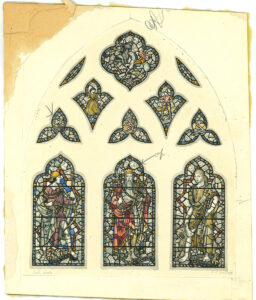 By Ellie Jones, Cathedral Archivist
By Ellie Jones, Cathedral Archivist
This watercolour shows the R.D. Blackmore memorial window, painted by A. F. Erridge of J. Wippell & Co. Ltd, Exeter.
J. Wippell & Co. were founded in 1789 as a supplier of church furnishings and clerical vestments and robes. These have continued to be the mainstay of the business until this year when, sadly, the company is due to stop trading. In 1896 they added stained glass to their portfolio of ecclesiastical services, and their work can be seen in four windows in the Cathedral, all designed by A.F. Erridge.
Arthur Frederick Erridge (1899-1961), the son of a London road sweeper, was a talented painter in watercolour and oil and studied at the Central School of Arts and Crafts. He spent his early career with the leading London manufacturers of glass and leaded stained glass windows, James Powell & Sons. After working as an agricultural labourer in Suffolk during the Second World War he returned to the world of stained glass, this time as one of the principal designers for J. Wippell & Co. He created designs for windows in many churches in England, Wales and America.
Erridge’s Blackmore memorial window was a modernisation of the earlier one by Percy Bacon Brothers of London dating from 1904, installed as a tribute to the author Richard Dodderidge Blackmore (1825-1900). Blackmore’s most popular novel was the romantic adventure Lorna Doone (1869), set on Exmoor in the 17th century. The memorial window features the story’s heroes, the lovers John Ridd and Lorna Doone, side by side in the tracery lights. Above them John Ridd is shown fighting his enemy and rival Carver Doone in a key scene from the story. The main lights depict the biblical figures Jonathan, King David, and Sampson, chosen to represent the principal strengths of John Ridd: love and tenderness, courage, and strength. A comparison between the watercolour and the window itself reveals a number of interesting differences: in the painting John Ridd and Carver Doone confront each other on horseback, but in the window the fight is bareknuckle; the difference in status between heiress Lorna Doone and farmer John Ridd is shown more clearly in their dress in the window; and King David is more youthful in the window.
The Blackmore window can be seen at the western end of the south nave aisle, above the entry door to the Cathedral. Erridge’s other windows are the Nativity and Courtenay windows in the south nave aisle, and the east window in the Chapel of St John the Baptist.